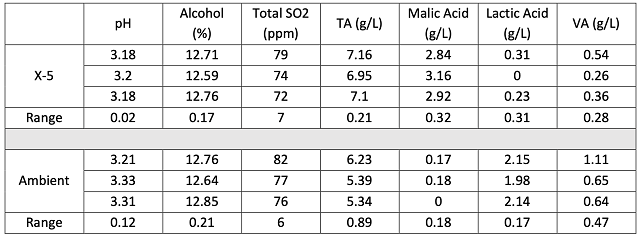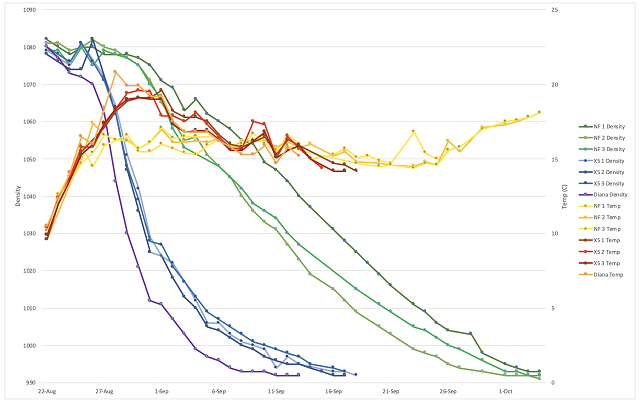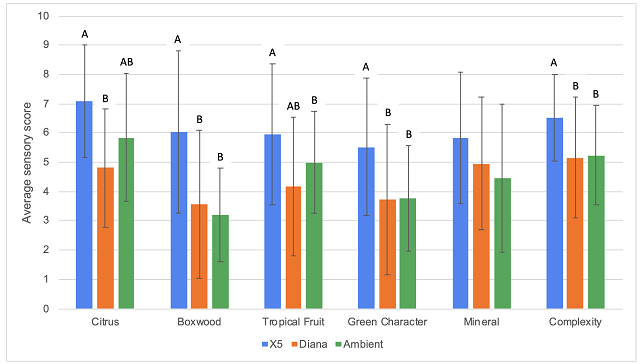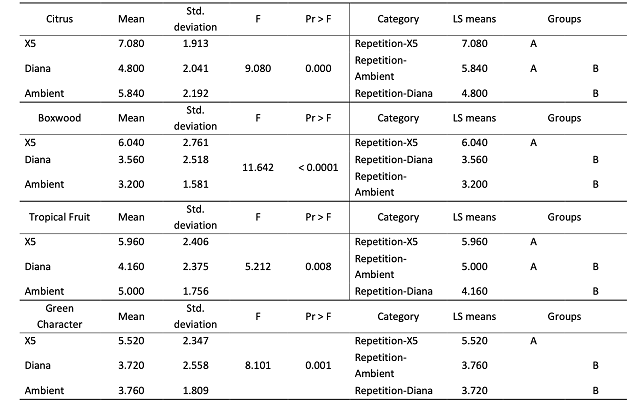Comparing Varietal Character and Terroir Expression in Sauvignon Blanc Inoculated with a Commercial Yeast Strain vs. Ambient Starter Culture (2019)
Matthieu Finot
King Family Vineyards
Summary
Sauvignon blanc is made in many styles around the world including the thiol-driven, fruity and herbaceous expression of New Zealand and the citrus and mineral expression found in white Bordeaux wines. Choice of yeast strain is one of several aspects that contribute to the expression of varietal character in Sauvignon Blanc. In this experiment, three different yeast treatments were used on the same Sauvignon Blanc juice: Zymaflore X5 (Laffort), Diana (Agrovin), and a vineyard starter culture. Juice inoculated with the vineyard starter culture fermented slower than juice inoculated with either commercial yeast, and finished fermentation with malolactic fermentation nearly complete. In sensory analysis comparing wines from three yeast treatments, the wine fermented with X5 had significantly higher scores for citrus, boxwood, tropical fruit, green/herbaceous character (Figure 2, Table 3). When participants were asked which wine had the most Sauvignon Blanc varietal character 21 of 25 chose the X5 while 2 chose Diana and 2 chose the ambient starter. Open ended questions indicated tasters who preferred the ambient starter culture felt this better exemplified the “Classic French style” with more minerality. Those that preferred X5 frequently mentioned the aromatic complexity with boxwood as a varietal distinctive. Choice of yeast strain can be a significant driver of the expression of varietal character in Sauvignon Blanc, however results here were complicated by the occurrence of malolactic fermentation. Future experimentation will be done to test yeast effects when malolactic fermentation is prevented.
Introduction
This is the first year King Family Vineyards has made a varietal Sauvignon Blanc using fruit from the Crown Orchard in Batesville, Virginia. When formulating a winemaking plan, Matthieu Finot desired a mineral-driven, Bordeaux style Sauvignon Blanc rather than a high thiol New Zealand style Sauvignon Blanc. With this in mind, the winemaking protocol was designed with permissive oxygen at the press and barrel fermentation and did not include elements meant to increase thiols such as dry ice/CO2 blanketing, specialized nutrition or added enzymes. A short stabulation was included to allow time to raise the vineyard starter culture. After fermentation, wine was aged in barrels on lees with low free SO2.
The choice of yeast strain for Sauvignon Blanc has a considerable impact on the flavor profile and varietal expression. In addition to converting sugar to alcohol during fermentation, yeast convert non-volatile precursors to aromatic molecules through the action of enzymes. Enzymes are genetically encoded and yeast strains may have different variants of genes, leading to different ability among strains to convert precursors to volatile compounds1,2,3. For example, there can be up to 25-fold difference in the expression of thiols in wines produced by one yeast strain vs another (Bruce Zoecklein, personal communication). Enological companies now market specific yeast strains as “thiol producing”, because they have a high number of precursor-converting genes.
The purpose of this experiment was to determine which yeast strain best expressed varietal character in the style of a Bordeaux Sauvignon Blanc at this site. Three yeast options were chosen for the experiment. Zymaflore X5 (Laffort) is marketed for aromatic white wine production with high intensity of thiols, varietal aromas and fermentation aromas. Viniferm Diana (Agrovin) is also marketed for aromatic white wine production, to enhance varietal typicity and encourage volatile thiol release. The third treatment included use of an ambient fermentation starter culture raised using fruit from the vineyard.
Many Virginia winemakers are using starter cultures rather than commercial yeast for some fermentations. These are thought to lead to greater complexity in the wine but come with several additional risks. Many studies show a broad diversity of microbes present in both inoculated and non-inoculated fermentations4. When tracked with molecular techniques, indigenous fermentations often show greater diversity of yeast species in the first third of the fermentation, and several strains of Saccharomyces cerevisciae acting throughout the fermentation, often with one strain gaining dominance by the end5. Depending on the condition of the grapes and grape handling protocols, non-Saccharomyces yeast strains are often found into mid-fermentation even in juice/must inoculated with commercial yeast strains. The preparation of a starter culture in the winery or vineyard is also likely to influence the true diversity of the fermentation. It was beyond the scope of this study to track all of the species and strains involved in fermentation, rather, this study focused on practical outcomes such as fermentation kinetics, and the chemical and sensory properties of the finished wines.
Methods
Sauvignon Blanc grapes were hand harvested on Aug 14 from the Crown Orchard in Batesville, Virginia. After refrigeration overnight, grapes were whole cluster pressed to tank with the addition of 5 mL/ton Lafasse XL Press and 1.3 g/hL SO2. Juice was held in a cold tank under anaerobic conditions with daily mixing and CO2 sparging for 5 days (gentle stabulation). On the sixth day, juice was racked to neutral French oak barrels for fermentation. Turbidity at racking was 275 NTU. Barrels were inoculated with 20 g/hL yeast (X-5 or Diana) rehydrated in 25 g/hL Go Ferm Protect Evolution. The ambient fermentation was inoculated with a well-mixed vineyard starter. The protocol for preparation of the vineyard starter can be found in Appendix A. Fermentation was carried out in a cool cellar and was monitored daily for Brix and temperature. Chaptalization of 20 g/L sugar was done at 1/3 sugar depletion. At the completion of fermentation, 5 g/hL SO2 was added and wine was aged on lees.
Sensory analysis was completed by a panel of 33 wine producers. Due to social distancing practices put in place during COVID-19, blind sensory analysis was completed remotely. Wines were presented in randomly numbered bottles with instructions for tasting. Three wines were presented (X5, Diana, ambient) and tasters were asked to score each wine on a scale from 1 to 10 for citrus, boxwood, tropical fruits, green character (grassy, bell pepper, leafy, herbaceous), minerality and complexity. There were three tasting groups with the order of analysis balanced among groups. Open ended questions asking respondents:
- Which wine had the most Sauvignon Blanc varietal character? Which attributes contribute to your decision?
- Which wine do you prefer and why?
Descriptive scores were analyzed using repeated measures ANOVA. If significant differences were found among descriptive score, Tukey’s test was used to determine which categories were significantly different from one another.
Results
Grapes were harvested with 19°Brix with a pH = 3.13. The juice inoculated with Diana yeast fermented the fastest and warmest (Figure 1). X5 yeast was nearly as robust in fermentation as Diana while the juice inoculated with the vineyard starter culture took the longest to complete fermentation and did so at lower fermentation temperature. The fermentations inoculated with the vineyard starter culture also had greater variation in progress compared to the barrels inoculated with X5 (only one barrel of Diana was tracked).
Primary chemistry after fermentation indicated that all of the barrels completed primary fermentation (glucose/fructose <1.0 g/L). Diana yeast appear to have produced more SO2 during fermentation than the other two treatments, due to notably higher total SO2 (Table 1). Though alcohol conversion and pH were largely the same regardless of yeast strain, volatile acidity was quite different (Table 1). The wine inoculated with the vineyard starter culture underwent some malolactic fermentation while the wine inoculated with commercial yeast did not (Table 1). Replicate barrels of wine inoculated with X5 and vineyard starter culture were further analyzed after 6 months of aging (Table 2). All three fermentations from the vineyard starter culture underwent considerable malolactic fermentation while the fermentations inoculated with X5 underwent very little malolactic conversion. The occurrence of malolactic fermentation likely caused the shift in pH and TA, and higher volatile acidity in the ambient fermented wines. It also likely affected perception of sensory attributes.
In sensory analysis comparing wines from three yeast treatments, the wine fermented with X5 had significantly higher scores for citrus, boxwood, tropical fruit, green/herbaceous character (Figure 2, Table 3). Wines inoculated with Diana did not have significantly different scores from those inoculated with the vineyard starter culture. When participants were asked which wine had the most Sauvignon Blanc varietal character 21 of 25 chose the X5 while 2 chose Diana and 2 chose the ambient starter. Reasons for choosing both Diana and the ambient starter included attributes of minerality, flint, and acidity. Those that chose X5 frequently mentioned descriptors such as cut grass, cat pee, grapefruit, tropical fruit, and green pepper. When asked which wine they preferred, 15 chose the wine inoculated with X5, 5 chose the ambient and 4 chose Diana. Those that preferred the ambient starter culture felt this better exemplified the “Classic French style” with more minerality. Those that preferred Diana mentioned it had less cat pee and “herbality” than X5. Those that preferred X5 frequently mentioned the aromatic complexity with boxwood as a varietal distinctive.
Appendix A: Vineyard starter culture protocol
To prepare a starter for the ambient fermentation, 4-5 days prior to harvest, collect clean clusters and crush them into a cleaned and sanitized 6 gallon bucket with a removable lid. Add 30 ppm SO2. Keep the container of crushed fruit in the vineyard to limit its exposure to commercial yeast in the winery and allow the native yeast fermentation to begin. Temperature of the starter should be kept around 26°C (by shading or sun exposure). Monitor the starter for Brix depletion and temperature daily (or twice per day if it is moving briskly). Oxygenate the starter after 2 or 3 days. When the starter is around 1.045 - 1.030 (between 8 and 12° Brix), strain the pomace in the bucket and keep the fermenting juice for inoculation. Make sure to smell and taste the starter before inoculation to be sure that VA and ethyl acetate are not too high.
For this experiment, the following adjustments were made:
- The starter was set up at the time of harvest and juice was held cold until it was ready.
- The starter was located outside the winery rather than in the vineyard.
References
(1) Dubourdieu, D.; Tominaga, T.; Masneuf, I.; Gachons, C. P. des; Murat, M. L. The Role of Yeasts in Grape Flavor Development during Fermentation: The Example of Sauvignon Blanc. Am J Enol Vitic. 2006, 57(1), 81–88.
(2) Howell, K. S.; Klein, M.; Swiegers, J. H.; Hayasaka, Y.; Elsey, G. M.; Fleet, G. H.; Høj, P. B.; Pretorius, I. S.; de Barros Lopes, M. A. Genetic Determinants of Volatile-Thiol Release by Saccharomyces cerevisiaeduring Wine Fermentation. AEM 2005, 71 (9), 5420–5426.
(3) Thibon, C.; Marullo, P.; Claisse, O.; Cullin, C.; Dubourdieu, D.; Tominaga, T. Nitrogen Catabolic Repression Controls the Release of Volatile Thiols by Saccharomyces cerevisiae during Wine Fermentation. FEMS Yeast Research 2008, 8 (7), 1076–1086.
(4) Jackson, R. S. Wine Science: Principles and Applications, 4 edition.; Academic Press: Amsterdam, 2014.
(5) Egli, C. M.; Edinger, W. D.; Mitrakul, C. M.; Henick‐Kling, T. Dynamics of Indigenous and Inoculated Yeast Populations and Their Effect on the Sensory Character of Riesling and Chardonnay Wines. Journal of Applied Microbiology 1998, 85 (5), 779–789.
Figures and Tables
Table 1: Finished wine chemistry for three yeast inoculations of Sauvignon Blanc (ICV labs)

Table 2: Finished wine chemistry for replicate barrels of X-5 and Ambient fermentations (ICV labs)

Figure 1: Fermentation kinetics for replicate barrels of three yeast treatments of Sauvignon Blanc (in-house data)

Figure 2: Sensory scores for wine from three yeast inoculations of Sauvignon Blanc

Table 3: Sensory statistics for wine from three yeast inoculations of Sauvignon Blanc


